Back to Journals » Advances in Medical Education and Practice » Volume 13
Factors Influencing Undergraduate Students’ Preference of Health Sciences Specialties
Authors Gameraddin M , Al-sultan K, Salih S , Gareeballah A , Hasaneen M, Alomaim W, Omer A
Received 11 June 2022
Accepted for publication 26 September 2022
Published 21 October 2022 Volume 2022:13 Pages 1351—1358
DOI https://doi.org/10.2147/AMEP.S377344
Checked for plagiarism Yes
Review by Single anonymous peer review
Peer reviewer comments 3
Editor who approved publication: Dr Md Anwarul Azim Majumder
Moawia Gameraddin,1 Kamal Al-sultan,1 Suliman Salih,2 Awadia Gareeballah,1 Mohamed Hasaneen,2 Wijdan Alomaim,2 Awatif Omer1
1Department of Diagnostic Radiologic Technology, Faculty of Applied Medical Sciences, Taibah University, Al-Madinah, Saudi Arabia; 2Radiology and Medical Imaging Department, Fatima College of Health Sciences, Abu Dhabi, United Arab Emirates
Correspondence: Moawia Gameraddin, Department of Diagnostic Radiologic Technology, Faculty of Applied Medical Sciences, Taibah University, Al-Madinah, Saudi Arabia, Tel +966534821130, Email [email protected]
Background: It is necessary to determine what motivates students to pursue a particular specialty of their choosing to maintain a balance of medical practitioners from various disciplines.
Objective: The study aims to assess factors influencing undergraduate students of Applied Medical Sciences in choosing a specialty or discipline.
Methods: This cross-sectional study was conducted among first-year students of the faculty of applied medical sciences at Taibah University. One hundred and twenty-five participants were enrolled in the study. The students were asked to respond and complete the designed 9-item questionnaire. The Statistical Package for the Social Sciences (BM SPSS Statistics for Windows, Version 23.0, Armonk, NY: IBM Corp.) was used to analyze the data. A comparison between departments of the faculty was carried out.
Results: 125 participants were satisfied with their current faculty or discipline. They stated that medicine was the first choice (43.2%), followed by clinical nutrition (11.2%), dentistry (8%), diagnostic radiology (7.2%), and clinical laboratory (5.6%). The most important factors that affect students’ choice of discipline were helping patients and the community (32.8%), personal desire (30.4%), personal desire and helping patients (22.4%), and job opportunity and prestige (9.5%), with gender variations. Family enforcement and finances were less frequent factors affecting students’ specialty preferences.
Conclusion: The human medicine specialization was the first choice for most female and male undergraduate students who entered the faculty of applied medical sciences. Furthermore, the most influencing factor affecting students’ choices was helping patients and the community.
Keywords: applied medical sciences, students, speciality, choice, personal, factors
Introduction
Nowadays, the significance of Higher Education (HE) has particular importance since it spreads knowledge and advances of economic growth of the countries. Furthermore, HE has a fundamental impact on job creation and employment opportunities.
It is necessary to assess what motivates the students to select specific faculty or department of their choice to maintain the balance in medical professionals among various specialties. Previous studies reported that lifestyle factors and educational loans might be considered factors for selecting a student specialty.1–4
Previous studies have shown that students select their career or specialty according to many factors, such as social status and financial purpose. Several countries have researched the factors that led students to choose their faculty or specialty over many others.5–9 Various factors can influence this choice: individual qualities, perceived rewards, the appeal of particular specializations, and aspects of medical curricula.
The factors that affect the choice of university or college involve significant decisions that build the foundation for success and life and career. During the past half-century, the choice process for a university has changed considerably due to changes in student demographics and the progress of admissions and marketing practices.10 Few studies have been performed in Saudi Arabia to evaluate the reasons and factors behind different career choices among undergraduate Applied Medical students. It is essential to understand what inspires students to choose a particular specialty to keep the balance between many departments in medical institutions. Based on the mentioned factors, this study aims to identify why students choose a specific faculty or department, assess the student’s satisfaction with their current faculty, and find the differences between males and females.
Materials and Methods
Study Design and the Participants
This cross-sectional study was conducted among the first-year Applied Medical students in the faculty of applied medical sciences in 2019. They included students in diagnostic radiologic technology, clinical nutrition, and medical laboratory departments. A total of 125 participants took part in the study. Data were collected online by self-reported questionnaire using Survey Monkey. The link to the survey was distributed to the participants via emails, Twitter, and WhatsApp groups. Non-respondents were excluded in the first stage.
Independent Variables
Sociodemographic variables such as gender were coded as one for males and zero for females. The Grade Point Average (GPA) was categorized into less than 3.5, 4, and 3.5–4.49. The age was not categorized since the students’ age was approximately the same.
Dependent Variables
The participants were asked to respond to the satisfaction question. The score of satisfaction was assessed using a three-point Likert scale. It was ranged between 1–3, as 1 = disagree, 2 = agree, 3 = strongly agree. The other questions focused on reasons for choosing the faculty or department. Cronbach’s α test was used to evaluate items for internal reliability. Cronbach’s alpha coefficient was 0.50, indicating accepted reliability.
Questionnaire Design
The questionnaire was pre-tested on nine para-medical students from each department. The students had been asked to complete 8-item questions. The first questions were demographic data, specialty or department, and grading point collection (GPA).
Ethical Consideration
Participants, confidentiality was kept during the study analysis. Written informed consent was obtained from the participants. Every participant has the right to participate in the study or refuse. Before conducting the study, the ethical committee of the faculty of applied medical sciences approved the study and gave the number RAD 201701.
Statistical Analysis
The data were analyzed using Statistical Package for the Social Sciences (SPSS.) For Windows Version 23.0 (SPSS. Inc.; Chicago, IL, USA). Descriptive statistics were used for the analysis. The Chi-square test was applied to find associations between the different variables, and ANOVA and the Student’s t-test. “A P-value less than 0.05 was considered statistically significant”.
Results
A total of 125 undergraduate students were selected for the study. Among the participants, 44 (35.2%) were males, and 81(64.8%) were females. The mean age was 20.17±1.275 years. The participants were the students who were enrolled in the departments of the faculty of applied medical sciences; 35 (28%) from the Radiology department, 40 (32%) from the clinical laboratory, and 50 (40%) from the clinical nutrition department. Most students have GPA scores> 4, as shown in Table 1.
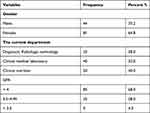 |
Table 1 Descriptive Statistics for the Study Participants |
Table 2 summarizes the assessment of students, satisfaction with their current faculty or department. It was observed that females are more satisfied than males (44.4% vs 34.1%), and students in clinical nutrition strongly agreed with their discipline more than Radiology and clinical nutrition students. A 76.5% of the students with GP.A.> 4 were more strongly satisfied with their field than the other students with GPAs ranging from 3.5–4.49. On the other hand, 60% of the students in the clinical laboratory agreed with their field more than the other two departments (45.7% and 38%).
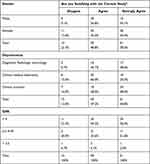 |
Table 2 Assessment of Students’ Satisfaction Towards Their Current Faculties or Departments |
The overall accuracy rate for satisfaction was 74.26% (2.28/3.10). The total mean score of satisfaction was 2.28. Regarding gender, GAP, and departments, there was no significant difference in the satisfaction score (p-value < 0.05), as shown in Table 3.
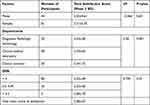 |
Table 3 Comparison of the Score Mean of Satisfaction of the Students with Gender, Grade Point, and Departments |
The faculties/departments chosen by the students before joining the current discipline are demonstrated in Table 4. Most students whose GPA was greater than four chose the faculty of medicine (Figure 1). The faculty of medicine was selected by 43.2% of the students, followed by clinical nutrition (11.2%), dentistry (8.0%), diagnostic radiology (7.2%), and the clinical laboratory (5.6%). Regarding association with gender, male students in radiology and clinical laboratory departments scored significantly higher than females (p-value < 0.05).
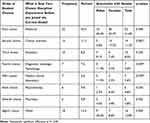 |
Table 4 Faculties/Departments Chosen by the Students Before Joining the Current Health Discipline |
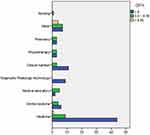 |
Figure 1 Distribution of students’ GPA and the faculties /departments they preferred. |
The factors associated with reasons for choosing a medical faculty or department are summarized in Figure 2. Beneficial for society, patients, personal desire, and job opportunity were the most impactful factors affecting students’ choice of faculty or discipline. 32.8% of the students responded for beneficial to society patients, 30.4% for personal desire, and 9.6% for job opportunities without gender variations. Family desire and finances were less frequent factors affecting the students’ choices.
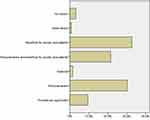 |
Figure 2 Distribution of factors/reasons associated with students’ choice of faculties or disciplines. |
Discussion
Through their academic programs, universities contribute to the development of human capital and research and lay the groundwork for society, nation, technology, culture, and the economy.11 The graduates do not make this life-changing decision without influential factors such as community and family. This study aimed to assess the factors influencing medical faculties’ choices among the first-year faculty of applied medical sciences students at Taibah University.
Several factors affect a student’s decision for further study. The study found that medicine was the first choice for 43.2% of the students, clinical nutrition, Dentistry for 8%, Diagnostic Radiologic Technology for 7.2%, Medical laboratory for 5.6%, and 4.8% for Physiotherapy and Pharmacy. This result is similar to Nemri et al,12 who reported that medicine was the first choice for most medical students entering King Abdul-Aziz University in Jeddah, Saudi Arabia. In Saudi Arabia, few studies demonstrated the related preferences among medical students to the faculty or specialty13–15 Furthermore, we found that gender and GPA have no significant association with student choice for particular faculty or discipline.
The present study evaluated factors associated with choosing a medical faculty or department. It was found that the students decided to be the beneficiaries of the discipline for society, and helping patients was the most important factor that let them prefer their current profession. The second reason was a personal desire. Our findings match those of Crossley et al,16 who found that helping people and the community was the most motivating factor for medical students to choose their discipline. Similarly, a study performed in Sydney among dental students reported that helping people was an essential motivating factor for their studies.17 Our findings agreed with previous studies on the beneficiary of community and helping people.
The current study showed that personal desire was the second reason students chose the program. This finding is consistent with previous studies, which reported that “some of the most important attributes that influence the students` decision making seem to be: personal interest.”18,19 Therefore, personal desire is an important characteristic that should be considered in establishing a university program.
Job opportunity, financial, family enforcement, and prestige were less frequent factors associated with students’ choice of faculty or discipline. This result is not different from those reported in the literature. A recent survey showed that financial, marketing, academic reputation, and family influenced college selection affect choice for today’s students.20 Job opportunity and prestige were reported as “a deciding factor for youth’s career decision”.21,22 These factors are motivated by intrinsic factors governed by students’ interests in specific jobs and employment that are personally fully satisfying.23,24 The actions that follow the inherent characteristics are stimulated by interest, curiosity or pleasure, and enjoyment, including job satisfaction, advancement in career, personality traits, and learning experiences.24,25 Interestingly, the students in this study were satisfied with their current faculty and discipline.
The results generated from this study would help the health councils plan to increase or decrease the number of medical professionals in various specialties, including radiography, nutrition science, and medical laboratory. No gender differences affected these findings. These results may not be generalized as it was conducted by one faculty at Taibah University. Further studies in multicentre are needed to confirm the results of the present study.
Conclusion
Before joining their current departments, medicine, clinical nutrition, and Dentistry were the top three specialties selected by the students of Applied Medical Sciences. Servicing the community and patients and personal desire were the most influencing factors that affected students’ preference for faculty or discipline.
Ethics Statement
We confirmed that written informed consent was obtained from the study participants and followed the guidelines outlined in the Declaration of Helsinki.
Disclosure
The authors have no conflict of interest regarding this study.
References
1. Kumar A, Mitra K, Nagarajan S, Poudel B. Factors influencing medical students’ choice of future specialization in medical sciences: a cross-sectional questionnaire survey from medical schools in China, Malaysia, and regions of the South Asian Association for Regional Cooperation. N Am J Med Sci. 2014;6(3):119–125. doi:10.4103/1947-2714.128473
2. Kohler PA, Edwards TA. High school students’ perceptions of nursing as a career choice. J Nurs Educ. 1990;29(1):26–30. doi:10.3928/0148-4834-19900101-08
3. Gallagher JE, Patel R, Donaldson N. Understanding motivation: a qualitative study of dental students’ professional career choices. Eur J Dent Educ. 2008;12(2):89–98. doi:10.1111/j.1600-0579.2008.00506.x
4. Bernabé E, Icaza JL, Delgado-Angulo EK. Reasons for choosing dentistry as a career: a study involving male and female first-year students in Peru. Eur J Dent Educ. 2006;10(4):236–241. doi:10.1111/j.1600-0579.2006.00422.x
5. Mashlah AM. Dentistry students’ reasons for choosing dentistry as a career in Damascus University. East Mediterr Health J. 2012;18(5):508–514. doi:10.26719/2012.18.5.508
6. Grayson MS, Newton DA, Thompson LF. Payback time: the relationships between debt and income and medical student career choice. Med Educ. 2012;46(10):983. doi:10.1111/j.1365-2923.2012.04340.x
7. Crossley ML, Mubarik A. A comparative investigation of dental and medical students’ motivation towards career choice. Br Dent J. 2002;193(8):471–473. doi:10.1038/sj.bdj.4801599
8. Al-Bitar ZB, Sonbol HN, Al-Omari IK. Reasons for choosing dentistry as a career by Arab dental students. Eur J Dent Educ. 2008;12(4):247–251. doi:10.1111/j.1600-0579.2008.00526.x
9. Hallissey J, Hannigan A, Ray N. Reasons for choosing dentistry as a career–a survey of dental students attending a dental school in Ireland during 1998–99. Eur J Dent Educ. 2000;4(2):77–81. doi:10.1034/j.1600-0579.2000.040205.x
10. Kinzie J, Palmer M, Hayek J, Hossler D, Jacob SA, Cummings H. Fifty years of college choice: social, political and institutional influences on the decision-making process. New Agenda Series. 2004;5(3):658.
11. Ab Aziz K, Harris H, Richardson S, Ab Aziz NA. Drivers for university research performance: investigating the researchers’ dynamics IBIMA. Bus Rev. 2012;2012:32
12. Nemri IA, Agabawi AK, Akel MS, et al. Factors affecting the specialty choice of medical students at King Abdulaziz University in Jeddah, Saudi Arabia. Int J Commun Med Public Health. 2015;2:570–575. doi:10.18203/2394-6040.ijcmph20151049
13. Mehmood SI, Kumar A, Al-Binali A, Borleffs JC. Specialty preferences: trends and perceptions among Saudi undergraduate medical students. Medical Teacher. 2012;34(sup1):S51–S60. doi:10.3109/0142159X.2012.656753
14. Al-Faris E, Kalantan K. Career choices among Saudi medical students. Acad Med. 1997;72(1):65–67.
15. Al-Omar BA. Knowledge, attitudes and intention of high school students towards the nursing profession in Riyadh city, Saudi Arabia. Saudi Med J. 2004;25(2):150–155.
16. Crossley ML, Mubarik A. A comparative investigation of dental and medical student’s motivation towards career choice. Br Dent J. 2002;193(8):471–473.
17. Gietzelt D. Social profiles of first-year dentistry students at the University of Sydney. Aust Dent J. 1997;42(4):259–266. doi:10.1111/j.1834-7819.1997.tb00131.x
18. Calkins LN, Welki A. Factors that influence choice of major: why some students never consider economics. Int J Soc Econ. 2006;33(8):547–564. doi:10.1108/03068290610678707
19. Learning about learning: students’ course selection; 2004. Available from: http://papers.ssrn.com/sol3/papers.cfm?abstract_id=651003.
20. Atitsogbe KA, Moumoula IA, Rochat S, Antonietti JP. Rossier J Vocational interests and career indecision in Switzerland and Burkina Faso: cross-cultural similarities and differences. J Vocat Behav. 2018;107:126–140. doi:10.1016/j.jvb.2018.04.002
21. Wüst K, Leko Šimić M. Students’ career preferences: intercultural study of Croatian and German students. Econ Sociol. 2017;10:136–152. doi:10.14254/2071-789X.2017/10-3/10
22. Gokuladas VK. Factors that influence first-career choice of undergraduate engineers in software services companies: a South Indian experience. Career Dev Int. 2010;15:144–165. doi:10.1108/13620431011040941
23. Kunnen ES. The effects of career choice guidance on identity development. Educ Res Int. 2013;901718. doi:10.1155/2013/901718
24. Deci EL, Koestner R, Ryan RM. Intrinsic and extrinsic motivations: classic definitions and new directions. Contemp Educ Psychol. 2000;25:54–67. doi:10.1006/ceps.1999.1020
25. Nyamwange J. Influence of students’ Interest on Career Choice among First Year University Students in Public and Private Universities in Kisii County, Kenya. J Educ Pract. 2016;7(4):96–102.
 © 2022 The Author(s). This work is published and licensed by Dove Medical Press Limited. The full terms of this license are available at https://www.dovepress.com/terms.php and incorporate the Creative Commons Attribution - Non Commercial (unported, v3.0) License.
By accessing the work you hereby accept the Terms. Non-commercial uses of the work are permitted without any further permission from Dove Medical Press Limited, provided the work is properly attributed. For permission for commercial use of this work, please see paragraphs 4.2 and 5 of our Terms.
© 2022 The Author(s). This work is published and licensed by Dove Medical Press Limited. The full terms of this license are available at https://www.dovepress.com/terms.php and incorporate the Creative Commons Attribution - Non Commercial (unported, v3.0) License.
By accessing the work you hereby accept the Terms. Non-commercial uses of the work are permitted without any further permission from Dove Medical Press Limited, provided the work is properly attributed. For permission for commercial use of this work, please see paragraphs 4.2 and 5 of our Terms.
